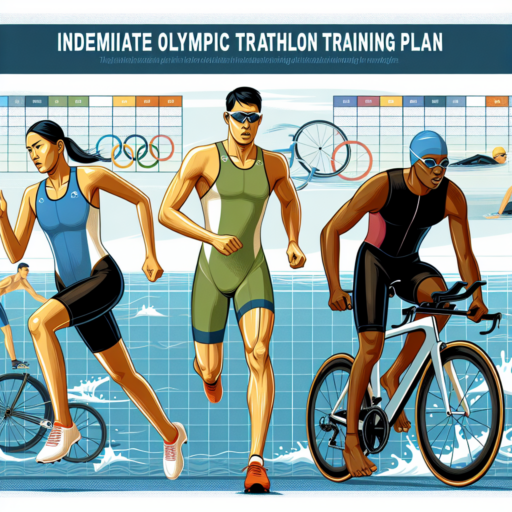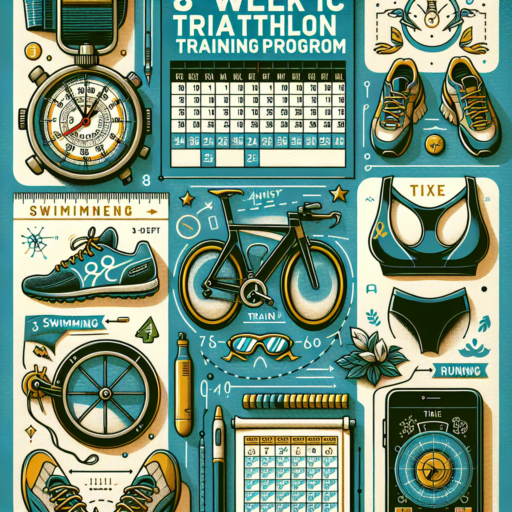Introduction to Intermediate Olympic Triathlon Training Plans
Embarking on an Olympic triathlon represents a significant challenge that combines the thrill of competition with the demand for advanced physical endurance and mental fortitude. Intermediate Olympic triathlon training plans are designed to equip athletes who have some experience in triathlon, aiming to improve their performance beyond the basics. These plans are meticulously structured to balance intensity and recovery, ensuring that athletes can push their limits while minimizing the risk of injury.
At the intermediate level, training plans become more personalized, focusing on the athlete’s specific strengths and areas for improvement. A typical plan spans several months and includes varied workouts across swimming, cycling, and running disciplines. Key components of an intermediate plan involve increasing workout distances gradually, incorporating speed work, and introducing brick sessions to adapt the body to the demands of transitioning between sports.
Adherence to a well-structured training plan is crucial for success in the Olympic triathlon. It not only prepares the body for the physical toll of a 1.5km swim, a 40km bike ride, and a 10km run but also builds the mental resilience required to tackle each segment confidently. By following an intermediate Olympic triathlon training plan, athletes can aim for personal bests, more efficient race times, and an overall improved triathlon experience.
Understanding the Basics of Olympic Triathlon
The Olympic Triathlon stands as a multi-discipline sport that captivates athletes and spectators alike with its dynamic nature. This event showcases the ultimate test of endurance, strategy, and versatility as participants engage in swimming, cycling, and running in a sequential manner. Grasping the fundamentals of this rigorous competition offers a pathway into the heart of its excitement and challenges.
The Three Core Disciplines
- Swimming: The triathlon begins with a 1.5-kilometer swim, which serves as a critical phase to gain an early advantage. Athletes dive into open water, navigating through natural or man-made courses.
- Cycling: After the swim, athletes transition to a 40-kilometer bike ride. This segment tests their speed, stamina, and cycling technique over various terrains.
- Running: The final leg is a 10-kilometer run. This phase demands high levels of endurance and a strong mental focus as participants push towards the finish line.
Transition zones, known as T1 and T2, are pivotal elements within the Olympic Triathlon. T1, the swim-to-bike transition, and T2, the bike-to-run transition, require athletes to swiftly change gear and refocus their mindsets. Excelling in these transitions is as crucial as the individual disciplines themselves, often making or breaking an athlete’s overall performance.
The allure of the Olympic Triathlon lies not just in the physical prowess of its competitors but also in the strategic depth of managing energy and technique across three demanding sports. Understanding these basics invites both seasoned athletes and newcomers to appreciate the intricate layers of dedication, training, and spirit that define this prestigious event.
Key Components of an Effective Intermediate Training Plan
An effective intermediate training plan is crucial for those who have surpassed the beginner level and are looking to step up their fitness game. Building on a solid foundation, this plan introduces elements that are instrumental in propelling individuals towards more advanced levels of fitness. Among these, specific components stand out for their importance in a balanced and progressive training regimen.
Structured Progression
At the heart of any successful intermediate training plan is structured progression. This means that workouts systematically increase in difficulty, ensuring continuous improvement without causing overtraining or injury. Structured progression takes into account the principles of overload and adaptation, pushing the body just enough to foster growth and enhance performance over time. This approach allows for consistent gains in strength, endurance, and skill.
Variety in Exercise Selection
Another key component is variety in exercise selection. During the intermediate phase, it’s important to challenge the body in different ways to ensure all muscle groups are being worked effectively. Incorporating a mix of strength training, cardiovascular exercises, flexibility workouts, and skill-specific drills can keep the training interesting and beneficial. This variety not only prevents boredom but also helps to avoid plateaus, making sure progress continues unabated.
Rest and Recovery
Lastly, no intermediate training plan is complete without proper emphasis on rest and recovery. While increasing workout intensity and frequency, it’s crucial to balance this with adequate rest days and recovery modalities such as stretching, foam rolling, and perhaps most importantly, sleep. These elements are essential to prevent overuse injuries, allow muscles to repair and grow stronger, and ensure you’re getting the most out of your training efforts.
Weekly Breakdown: Balancing Swimming, Cycling, and Running
The key to excelling in a multisport routine lies in the art of balancing. Swimming, cycling, and running each play pivotal roles in building a harmonious trifecta of endurance, speed, and power. Achieving a balanced weekly schedule can help athletes optimize performance while minimizing the risk of injury.
Creating a Balanced Schedule
Starting the week with a clear plan is essential. Allocate specific days for each activity, ensuring there’s an equal focus on swimming, cycling, and running. It’s not just about the days you train, but also the intensity and duration of each session. For instance, incorporating long-distance runs on days when your body is most rested can lead to better endurance gains.
Incorporating Recovery
Balance is not just about training; it’s equally about recovery. Integrating rest days and low-intensity workouts ensures your body has time to recuperate. This approach helps in reducing fatigue and preparing your muscles for the next set of rigorous exercises. Remember, swimming can be a great low-impact option for recovery days, aiding in muscle relaxation and cardiovascular maintenance without the stress on your joints.
By focusing on a balanced weekly breakdown, athletes can improve their performance in swimming, cycling, and running, while also enjoying the journey. It’s about smart training, listening to your body, and pushing the boundaries while respecting your limits.
Nutrition and Hydration Strategies for Triathletes
Mastering the art of nutrition and hydration is pivotal for triathletes aiming to enhance their performance and endurance. The unique demands of training for and participating in triathlons necessitate a tailored approach to fueling the body. Understanding the optimal nutrition and hydration balance can significantly impact an athlete’s ability to train effectively and achieve peak performance during competition.
Optimizing Pre-Race Nutrition
Beginning with the days leading up to the event, triathletes should focus on loading their bodies with the right balance of carbohydrates, proteins, and fats. Carbohydrates are particularly crucial as they serve as the primary energy source during high-intensity activities. Incorporating a variety of whole grains, fruits, and vegetables can ensure a steady supply of energy, while lean proteins support muscle repair and recovery. Paying close attention to hydration levels is also essential, with an emphasis on steadily increasing fluid intake to ensure optimal hydration status at the starting line.
During the Event: Balancing Hydration and Energy
During the triathlon, maintaining a balance between hydration and energy becomes the key to sustaining performance. Triathletes should aim to consume easily digestible carbohydrates to maintain energy levels, such as energy gels, chews, or bars, along with a consistent intake of fluids to prevent dehydration. It’s important to personalize fluid and energy intake based on individual needs, the climate, and race duration, as these factors significantly influence sweat rates and energy expenditure.
Post-Race Recovery Nutrition
After crossing the finish line, the focus shifts to recovery. This phase is critical for replenishing glycogen stores, repairing muscle tissue, and rehydrating the body. Consuming a mix of carbohydrates and proteins shortly after finishing can kickstart the recovery process. Hydration continues to be a priority, with an emphasis on replacing any fluid losses experienced during the race. Incorporating electrolytes into post-race beverages can further aid in the rehydration process and help restore electrolyte balance.
Injury Prevention Tips during Intense Training
Engaging in intense training routines requires not just dedication and hard work, but also a keen focus on preventing injuries. These injuries, if overlooked, can significantly derail progress and lead to long-term setbacks. Thus, incorporating deliberate practices aimed at injury prevention is paramount for anyone involved in high-intensity workouts.
Start with a Proper Warm-up
One of the foundational elements of injury prevention is starting each training session with a proper warm-up. A dynamic warm-up, which includes activities that increase your heart rate and move your joints through their full range of motion, prepares your body for the demands of intense training. It not only improves performance but also reduces the risk of injuries by increasing blood flow to the muscles and improving tissue elasticity. Remember, a well-executed warm-up is your first step towards a safer training session.
Focus on Technique and Form
Maintaining proper technique and form during intense training is crucial for preventing injuries. Poor form not only hinders your progress but also increases the risk of strain and injury. Whether you’re lifting weights, running, or engaging in any form of intense exercise, ensure that you’re performing each movement correctly. It’s often beneficial to work with a coach or trainer who can provide immediate feedback and guidance. Focusing on technique ensures that you’re not only working efficiently but safely.
In conclusion, injury prevention during intense training is crucial for long-term success and health. By starting with a proper warm-up, focusing on technique and form, and incorporating rest and recovery into your routine, you can minimize the risk of injury and ensure that your training remains effective and safe. Remember, the goal is to build strength and endurance sustainably, without the setbacks of injuries.
Monitoring Your Progress: Tests and Milestones
Keeping track of your progress through tests and milestones is an essential aspect of achieving any goal. Whether you’re learning a new skill, working towards a career advancement, or aiming to improve your personal development, these methods provide tangible evidence of your advancements and areas needing improvement. Not only do they serve as motivators, but they also offer invaluable insights into your journey, helping to refine strategies and methods moving forward.
Tests play a pivotal role in monitoring progress. They are structured evaluations designed to quantitatively measure your knowledge or skill level at any given point. By regularly scheduling tests, you can gather data on your performance, understanding which areas have improved and which require further attention. This ongoing feedback mechanism is crucial for adapting your learning or development strategy to ensure continual progress.
Milestones, on the other hand, are significant points along your journey that represent major achievements or stages of development. They are more qualitative than tests and offer a moment to reflect on the journey thus far. Setting clear, achievable milestones keeps motivation high and provides a framework for celebrating successes, no matter how small. These moments of reflection are essential for maintaining a positive outlook and momentum towards your ultimate goal.
Tapering Before the Race: Reducing Volume, Maintaining Intensity
Race Day Strategy: Pacing, Transitions, and Mental Prep
Tapering Before the Race: Reducing Volume, Maintaining Intensity
As the race day approaches, athletes embark on the taper phase, a crucial period of training adjustments designed to optimize performance. The essence of tapering lies in reducing the volume of training while maintaining the intensity. This strategic reduction allows the body to repair, recover, and strengthen, setting the stage for peak performance. It’s a delicate balance; decrease too much, and you risk losing fitness, reduce too little, and the body remains in a fatigued state.
The key to successful tapering is understanding the individuality of the process. There’s no one-size-fits-all approach, and athletes should consider factors like their training load, recovery rate, and previous tapering experiences. Generally, a taper period can last anywhere from one to three weeks, gradually decreasing the volume of workouts by 20-50% while keeping the intensity unchanged. This method ensures that the muscles maintain their capacity for explosive power, critical for race day.
Aside from physiological benefits, tapering also offers a mental edge. During this period, athletes can focus on strategy, visualization, and building confidence without the mental and physical strain of high-volume training. This mental shift is key to approaching race day with a clear, focused mind, ready to tackle the challenges ahead.
Post-Race Recovery and Planning Your Next Challenge
After a grueling race, your body and mind need a well-deserved break. Post-race recovery is a crucial phase where your focus should be on allowing your body to heal and prepare for future challenges. It involves more than just rest; it’s about actively supporting your body’s recovery through various strategies including nutrition, hydration, and restorative exercises. Recognizing the importance of this phase can significantly enhance your performance in upcoming events.
Once you’ve given your body time to recuperate, the next step is to plan your next challenge. Whether you aim to tackle a longer distance, improve your time, or even participate in a completely different type of race, setting a new goal is essential for maintaining motivation and focus. Starting with a clear goal in mind, create a structured training plan that addresses your specific needs and weaknesses. Incorporating lessons learned from your previous race can be incredibly beneficial in preparing more effectively for your next challenge.
Rest and recovery don’t mean complete inactivity. Consider incorporating light exercises focused on mobility and flexibility, such as yoga or swimming, into your recovery phase. These activities can aid in muscle recovery, reduce soreness, and improve overall flexibility, making them a valuable part of both your recovery process and your preparation for future challenges. Additionally, now is the opportune time to engage in a thorough analysis of your previous performance, identifying areas for improvement and strategies that worked well.





